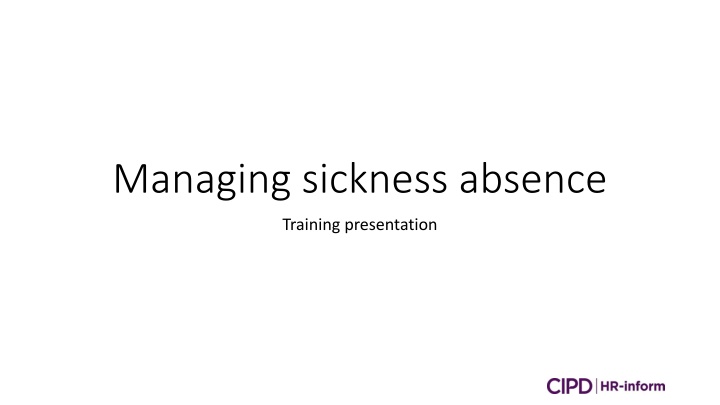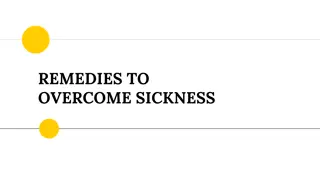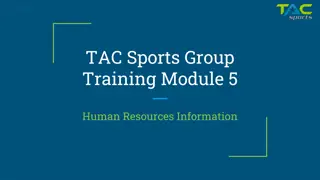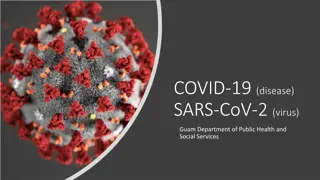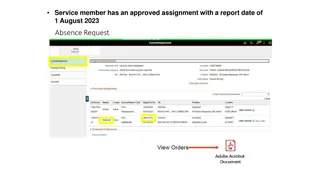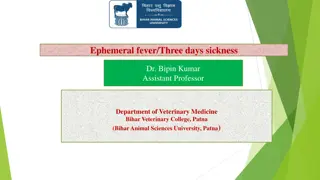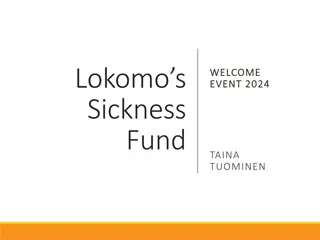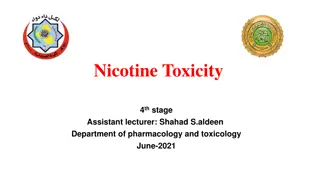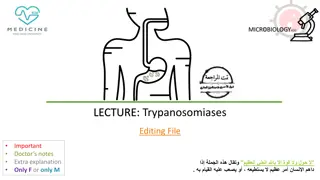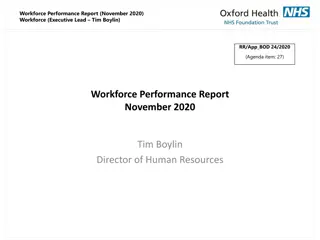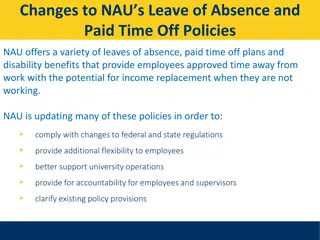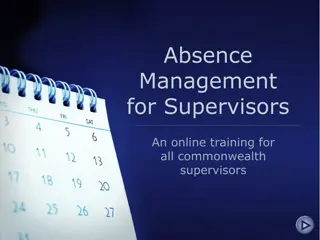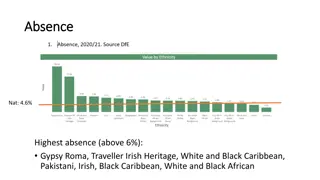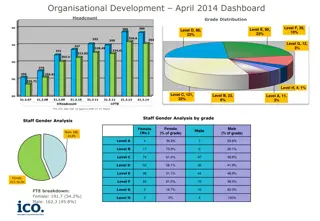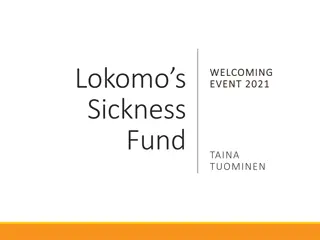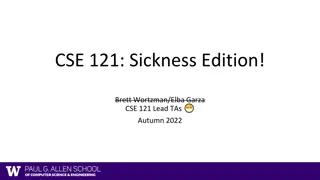Managing Sickness Absence Training Overview
This presentation covers the definitions of absenteeism, proactive steps to manage absenteeism, and guidance on handling long-term sickness absence. It addresses the impact of sickness absence on businesses and highlights the importance of focusing on managing absence levels, identifying causes, prioritizing employee health and wellbeing, and proactively monitoring absence.
Download Presentation

Please find below an Image/Link to download the presentation.
The content on the website is provided AS IS for your information and personal use only. It may not be sold, licensed, or shared on other websites without obtaining consent from the author.If you encounter any issues during the download, it is possible that the publisher has removed the file from their server.
You are allowed to download the files provided on this website for personal or commercial use, subject to the condition that they are used lawfully. All files are the property of their respective owners.
The content on the website is provided AS IS for your information and personal use only. It may not be sold, licensed, or shared on other websites without obtaining consent from the author.
E N D
Presentation Transcript
Managing sickness absence Training presentation
Managing sickness absence [Insert date] [Insert speaker name, insert speaker job title]
Training objectives This presentation is designed to: set out definitions of absenteeism identify proactive steps to manage this absenteeism provide guidance on handling a long-term sickness absence process.
Definitions Absenteeism Any absence that is not: agreed by the employment contract under legal rights eg time off for dependants agreed in advance by management.
Definitions Short-term sickness absence Any absence that is: [insert definition from absence policy eg absence less than a week] Will include persistent or repeated sickness. Even if absent for just one day, this will add to a large amount of time lost over the year.
Definitions Long-term sickness absence Any absence that is: [Insert definition from absence policy eg absence lasting more than a week] Accepted that the longer an absence is, the more difficult it is to return the employee to work.
Impact of sickness absence Annual cost of sickness absence estimated at 554 per employee. Average of 5.9 days sickness absence per employee per year. CIPD Health and Wellbeing 2019
Impact of sickness absence Other business costs: lack of continuity of service lower team morale increased workload and pressure placed on team members lower productivity fractured working relationships increased absenteeism from overworked colleagues.
What should managers be focused on? Managing absence to keep this to an acceptable level Identifying the causes of absence Taking care of employees health and wellbeing Monitoring absence proactively and sensitively
Absence management policy Sickness absence policy sets out internal rules on absence management. Employees will be aware of requirements to follow when absent and how this will be managed. Includes trigger point of [insert trigger point eg 3 absences in a rolling 6 month period]. Is also used to highlight the workplace support available for absent staff and how equality duties will be met.
Managing short-term sickness absence 1. Notification Personal notification from employee to line manager to: provide reason for absence confirm potential length of absence agree ongoing contact eg at start of each day/every other day. Record all absence notification in standard format using [insert name of form/software].
Managing short-term sickness absence 2. Certification For sickness absence lasting up to 7 calendar days, self-certificate can be completed on return to work. Asks employee to confirm: reason for sickness dates and times of sickness dates of absence. Place self-certificate on file information will be needed at a later stage.
Managing short-term sickness absence 2. Certification Medical certificate required as evidence of sickness absence lasting more than 7 days. GP fit note can recommend measures to return the employee to work including: phased return amended hours amended duties adaptations to the workplace. Place fit note on file information will be needed at a later stage.
Managing short-term sickness absence 3. Return to work meeting Purpose of meeting is to: find out facts about the absence identify any causes of absence and whether these are repeated discuss health and wellbeing. Needs to be held immediately after the employee s return to work to be effective. Tone is important this is not a disciplinary meeting but to discover information about the absence.
Managing short-term sickness absence 3. Return to work meeting Talk about areas including: reason for the absence was a medical expert/GP seen? are there work-related factors? is the employee now fit to return to work? has there been previous absences relating to the same reason? what steps can be taken to avoid future absences (employee and employer)? what support can be provided to the employee? Document discussions and keep a record of these on file.
Managing short-term sickness absence 4. Review and record absences Record every absence to allow patterns or high levels to be identified. Proactively review absence levels within team. Once the trigger point in the absence management policy is reached, formal absence management procedure is engaged. Ensure action is consistent to avoid complaints or allegations of unfair treatment.
Managing short-term sickness absence 5. Investigate and take formal action Use return to work forms to investigate absences. Consider using an investigation meeting with the employee to gain further information. After investigation, consider whether formal action is warranted under disciplinary or capability process.
Managing short-term sickness absence 5. Investigate and take formal action Process may result in formal sanction this is a useful deterrent to reduce absence levels. Sanction needs to be reasonable and in line with internal policy generally starting with letter of concern or verbal warning. Sanction can be built on when further formal action is carried out.
Managing long-term sickness absence 1. Meet with the employee/contact More important that proactive action is undertaken to avoid this becoming lengthy and ingrained. Research shows that the longer an employee is off work, the harder it is for them to return. Meet with the employee to discuss their absence consider different locations or use of technology.
Managing long-term sickness absence 1. Meet with the employee/contact Use meeting to discuss: reasons for absence expected length of absence long-term effects of sickness whether illness is re-occurring whether illness could be classed as a disability whether reasonable adjustments can be made to support a return what will be done going forwards eg contact, further reviews, OH review confirm review date of the situation. Document discussions and keep a copy on file.
Managing long-term sickness absence 2. Medical advice Can be useful to assess the likelihood of the employee returning to work. Request information on: prognosis whether the employee is fit to carry out their current role and work duties what adjustments are recommended.
Managing long-term sickness absence 2. Medical advice To request a medical report, managers will need to: send a letter to the employee advising that they are applying for a report advise the employee of their rights under the Access to Medical Reports Act 1988 request employee s written consent to the application.
Managing long-term sickness absence 2. Medical advice Employee has the right to: consent to the application and agree for the report to be provided to their manager directly consent to the application but state they wish to see the report before this is provided to their manager withhold their consent. If the manager has done everything reasonably possible to obtain medical information but the employee refuses consent, it may be fair to take action based on all the information available.
Managing long-term sickness absence 3. Discuss with employee Talk through the medical report with the employee this will contain new up-to-date information about their illness and potential to return. New considerations may include: making adjustments availability of alternative work (where necessary) redeployment or retraining ill health retirement waiting a further period for health improvements using a phased return to work.
Managing long-term sickness absence 4. Formal capability process At the end of the process, following full consultation with medical experts and the employee, there may be: no likelihood of the employee returning to work no adjustments available to support a return no suitable alternative roles available. In these circumstances, the formal capability process under the internal policy will apply.
Managing long-term sickness absence 4. Formal capability process Could result in a dismissal on the grounds of medical incapability. This is not unlawful provided a full and reasonable capability process has been carried out before decision is taken. This will include providing sufficient time for the employee to improve.
Managing long-term sickness absence Fair ill-health capability dismissal BS v Dundee City Council Before deciding to dismiss an employee on ill-health grounds, employers should: obtain proper evidence about the employee s medical condition and likely prognosis have sufficient and meaningful consultation with the employee and take his or her views into account, balanced against medical evidence ask whether a reasonable employer could be expected to wait any longer before dismissing the employee, taking into consideration any outstanding entitlement to sick pay, the availability of temporary staff and the size of the business
Managing long-term sickness absence Fair ill-health capability dismissal O Brien v Bolton St Catherine s Academy EAT held employer should have waited a further period before dismissing when medical evidence was presented that said the employee could immediately return. In the face of contradicting medical reports, further medical evidence needed to be sought. May also be expected to evidence impact on business of sickness absence why can t this be maintained for a further period?
Managing long-term sickness absence Fair ill-health capability dismissal Awan v ICTS EAT held that there is an implied contractual term preventing an employer from having the right to dismiss an employee for incapability whilst receiving benefits under the permanent health insurance scheme. Contractual terms and scheme prevision of PHI may need to be reviewed when looking to dismiss an employee.
Sickness absence and disability Where the employee s sickness can be classed as a disability, greater obligations will apply. A manager will be placed under a duty to make reasonable adjustments to reduce or remove disadvantages faced by the disabled employee, when compared to a non-disabled employee. This may require adjusting the normal absence management procedure eg methods of contacting, the capability policy, disregarding absences for disability etc.
False sickness It is important not to jump to conclusions or make false accusations as this could have severe consequences. As with any suspected misconduct, this will require a fair process to be followed. Investigating the alleged misconduct will require the normal return to work and certification process to be followed as this will form part of the evidence. If, after the investigation, it is deemed that there is a case to answer, this will be dealt with under the disciplinary process.
Dangers of a strict line Presenteeism Defined as being present at work whilst not physically or mentally well. Dangers: lack of productivity and quality whilst undertaking work takes longer to return to full fitness could spread illness among colleagues could result in additional feelings of overwork or stress.
Dangers of a strict line Other impacts: - low morale amongst team members - feelings of distrust and not feeling valued - disengagement with the organisation - higher retention - using holiday to cover sickness periods.
Key points: How absence is managed will depend on the type of absence Short-term absenteeism can be particularly damaging to the business especially if this is persistent or regular Long-term absenteeism is likely to last longer if this is left unmanaged Our absence management policy contains a procedure to follow for employees and managers Taking too harsh a line on absenteeism can have a negative impact
